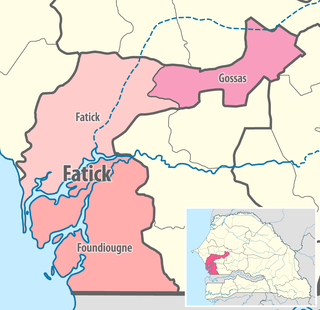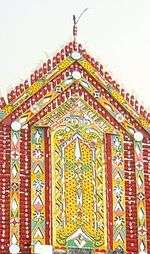Fatick Region
Fatick is the southwest region of the northern outcrop of Senegal. Its alternative name is Jinnak Bolon. The region is named for its capital city, Fatick.[2]
Fatick Region Région de Fatick | |
|---|---|
 Location of Fatick in Senegal | |
 Fatick région, divided into 3 départements | |
| Coordinates: 14°22′N 16°08′W | |
| Country | Senegal |
| Capital | Fatick |
| Départements | |
| Area | |
| • Total | 6,849 km2 (2,644 sq mi) |
| Population (2013 census) | |
| • Total | 684,652 |
| • Density | 100/km2 (260/sq mi) |
| Time zone | UTC+0 (GMT) |
| HDI (2017) | 0.482[1] low · 4th |
| Part of a series on |
| Serers and Serer religion |
|---|
  |
|
Deities |
|
Main doctrines |
|
Sacred places
|
|
Notable figures
|
|
Relations with other religions |
|
Education |
|
See also
|
|
History
The area is rich with Serer ancient and medieval history.[3][4][5] Many of the ancient Serer sites are found within this region.[3][5] It is also one of the holy places in the Serer religion.[6] The Xooy Ceremony (or Khoy), a divination festival by the Serer priestly class (the Saltigues) is held within this region once a year.[7] The population is overrun by the Serer people. Historically, it was part of the Serer pre-colonial Kingdom of Sine.[4][5] In 1859, the Battle of Logandème took place within this region. It was a battle of resistance by the Siin-Siin (Serer people of Sine) against French colonialism. It is called in some French scholarly works as the Battle of Fatick.
Departments
Fatick region is divided into 3 departments[2] :
References
- "Sub-national HDI - Area Database - Global Data Lab". hdi.globaldatalab.org. Retrieved 13 September 2018.
- (in French) Culture, demography, and Regional cultural center for Fatick region, Ministry of Culture, Senegal Archived 2007-11-17 at the Wayback Machine.
- (in French) Becker, Charles, "Vestiges historiques, trémoins matériels du passé clans les pays sereer", Dakar (1993), CNRS - ORS TO M
- (in French) Gueye, Pape Samba, "Analyses des blocages de l'introduction des langues nationales dans l'enseignement elementaire formel au Senegal: etude dans la commune de Fatick", Université Gaston Berger de Saint-Louis (2010)
- (in French) Sine-Saloum [in] Kassoumay "Archived copy". Archived from the original on 4 June 2012. Retrieved 13 July 2012.CS1 maint: archived copy as title (link) (Retrieved : 13 July 2012)
- African Studies Quarterly, Volume 14, Issue 3 (March 2014), "Fed Up: Creating a New Type of Senegal through the Arts", Guest Editors: Enz, Molly Krueger and Bryson, Devin, Published by the Center for African Studies, University of Florida, p. 36 (note 5), ISSN 2152-2448 (Retrieved 4 June 2018)
- (in French) "Révélation de saltigué : Touba va accueillir la dépouille d’une célébrité venue de Dakar" Xoy 2011 [in] La Sénégalaise, published 6/6/2011 (Retrieved : 13 July 2012)